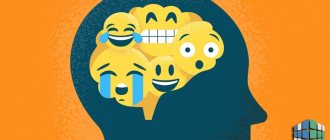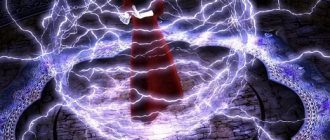Human emotional sphere: main components, characteristics, functions
Definition 1
The emotional sphere of a person is a set of emotional processes that reflect the spectrum of a person’s relationship to the world. That is, emotional processes are one of the forms of reflection of the real world by consciousness.
The emotional sphere of a person consists of several components:
- emotional tone is a characteristic at the level of sensations: how pleasant or unpleasant the impact of the stimulus is
- emotions themselves are a holistic reaction to an object or phenomenon, reflecting the possible degree of satisfaction or dissatisfaction of human needs with this object or phenomenon. Emotions are strongly related to needs and opportunities to satisfy them.
- emotionally stable relationships - feelings. They arise as a result of the generalization of emotions associated with an object. While emotions are a reaction regarding a situation, not the object itself. Feelings reflect the significance of an object for a person.
- emotional states are the general background of mental processes, mood. It is not associated with any object, it is a diffuse spread of a dominant emotion. The mood is formed on the basis of organic well-being (health and performance of the body), current life events. Emotional states can be activating - facilitating the implementation of any activity (their reverse side is apathy), tonic, i.e. resource-charged - affect, happiness, panic (their reverse side is depression), tensile - tension, fatigue, arising from increased load (their downside is relaxation).
- emotional properties of a person are stable manifestations of a person’s emotional sphere, which are already fixed in the structure of his personality. Emotional properties include: excitability (readiness to react emotionally), stability (optimal level of emotional state in an emotionally unstable situation), expressiveness (degree of expression and control of emotion), sensitivity (speed and flexibility of emotional reactions), intensity (depth of experienced emotions) , rigidity-plasticity (how long a person can experience a certain emotion when the stimulus has already disappeared or a new one has appeared)
Are you an expert in this subject area? We invite you to become the author of the Directory Working Conditions
Note 1
The main functions of emotional processes are reflection of reality and regulation of behavior. Thanks to reflection in the psyche, a person’s relationship with existing reality is formed, on the basis of which he is able to implement his behavior.
Components of emotional processes:
- impressive (internal experiences, ability to differentiate emotions, name them),
- physiological (changes in hormonal processes, galvanic skin response, blood pressure, ECG and heart rate, breathing, changes in pupils, muscle tension),
- expressive (ways of expressing emotions: verbal, non-verbal, symbolic).
The emotional sphere of a person reflects a person in three aspects of his integrity: biological nature (physiological characteristics, properties of the nervous system), individual response experience, cultural experience of a person (features of expression of emotions characteristic of a given society and culture, accepted emotions and taboo ones).
Finished works on a similar topic
Course work: Basis for the classification of emotional processes and methods for their study 430 ₽ Abstract: Basis for the classification of emotional processes and methods for studying them 250 ₽ Examination: Basis for the classification of emotional processes and methods for studying them 200 ₽
Receive completed work or specialist advice on your educational project Find out the cost
What is it: concept
Emotionality is the reaction of the psyche to various circumstances of life, which determines the direction of an individual’s actions. It is connected with the outside world through relationships of interdependence: what is happening around (the environment, the general atmosphere, people, events) directly affects the psycho-emotional state, which, in turn, can have an impact on the surrounding space.
There are some differences between emotions and feelings: the former are short-term, the latter are stable and longer lasting.
Classification of emotional processes
Emotional processes can be classified:
- by sign: positive, negative, ambivalent ones are also distinguished. Positive emotions are indicators of the adaptability and usefulness of an event that contributes to the satisfaction of needs. Negative emotions also contribute to the body's adaptability, but through removal from the unwanted stimulus.
- by duration: short-term reactions and long-term experiences. Reactions are characterized by instability and situationality, while experiences are characterized by stability and constancy.
- by intensity: weak and strong emotional processes are distinguished. The former include those that do not contain a strong expressive component, and the latter include those emotional processes that affect physiological processes. These are affect, passions, anxiety, frustration, stress.
- by content: modality of emotion (belonging to a certain category of sensory organs). This basis for classification is the most controversial. Different researchers have identified different numbers of emotions by modality. Here we can highlight the theory of differential emotions of K. Izard, who identified 10 main emotions: interest, joy, surprise, sadness, anger, disgust, contempt, fear, shame, guilt. However, it has a lot of criticism due to the unreasonable fundamental nature of these emotions. The main criterion for basic emotions is that they have deep roots and are manifested, among other things, in animals. Many emotions from K. Izard’s classification are characterized by socialization (shame, guilt, contempt). In Russian psychology, it is proposed to distinguish only 3 modalities: joy, anger and fear. This classification was proposed by V.D. Nebylitsyn. The author believes that all other emotions are derived from these three or their combinations.
- according to the degree of mobilization of the body: asthenic (suppressing: shame, sadness, melancholy) and sthenic (activating: joy, anger, surprise)
- according to the degree of awareness: conscious and unconscious. Unawareness can manifest itself in several aspects: the difficulty of tracking and realizing the beginning of the emergence of an emotion. Incorrect definition of the category of emotions, its interpretation in connection with the action.
- by degree of subjectivity: how much emotions are connected with the subject or not.
- by origin: there are innate emotions (which are associated with the implementation of certain instincts) and acquired (which are formed in individual and socio-cultural experience)
Another famous psychological researcher R. Lazarus identified such a basis for classifying emotions as the cause of the emotion. He believed that emotions have different contents due to different situations in which they arise. That is, emotion is the result of a comparison of the requirements of the situation and internal resources for realizing the needs in this situation. The emotion is positive if there are enough resources, the emotion is negative if there are not enough resources. One way or another, he singled out: anger, anxiety, fear, guilt, shame, sadness, envy, jealousy, disgust, happiness, pride, relief, hope, love, compassion.
Russian psychologist B.I. Dodonov identified an interesting basis for the classification of emotions - the subjective value of these emotions for a person. That is, the author relied not on the internal characteristics of the emotions themselves, but on the external ones, which are associated with the spheres of their manifestations. This classification identifies: altruistic emotions (arise in connection with the need for unification), communicative (arise in connection with the need for communication), gloric (arise in connection with the need for self-affirmation and recognition), practical (arise in the process of activity in connection with its successful or unsuccessful implementation), fearful (occur in situations of overcoming and struggle), romantic (occur in unusual and mysterious situations), gnostic (occur in situations of learning, cognition, research), aesthetic (associated with the concept of beauty), acquisitive (occur in in situations of accumulation, acquisition), hedonic (occur in situations of realization of various types of comfort).
Suffering and grief
Suffering is one of the fundamental emotions, during which a person loses heart, feels loneliness, lack of contact with people, and self-pity.
Suffering is the most common negative emotion and has important biological and psychological functions. Suffering is an integral part of our life.
Psychological functions of suffering: 1) communicating to myself and others that I feel bad, 2) encouraging action to reduce suffering, 3) providing moderate, negative motivation, 4) facilitating cohesion among people within a group. Both the causes and consequences of suffering are feelings, thoughts, and actions.
The consequence of the interaction of suffering with other emotions and affective-cognitive interactions is the experience of grief.
The main cause of grief is loss. The factors that determine grief can be divided into biological, cultural and psychological.
Grief is a biological reaction whose evolutionary significance is to ensure group cohesion in those species for which a social form of existence is necessary for survival. Grief is a more significant force for social cohesion than positive motives.
At the same time, sociocultural factors influence the experiences and motivational phenomena associated with grief (grief and guilt are correlated among members of the American sample and do not correlate among Norwegian subjects), the intensity and duration of grief (for example, in the Micronesian culture, the experience of grief in connection with the death of a loved one is intense, but short-lived, as in primates).
One of the most significant cultural determinants of grief is role loss due to disruption of Functional Connections resulting from the loss of a significant person.
Psychological causes of grief are associated with affective attachments to people, objects or ideals. Separation or loss of an attachment figure means: loss of joy and excitement, and depending on the age of the person and the nature of the object, loss of love, confidence and a sense of well-being.
Functions of grief.
Grief is contagious and evokes empathy, strengthening the bond between those who have suffered a loss. It has an adaptive value for the individual (it makes it possible to overcome oneself and adapt to loss).
Helps restore personal autonomy. Grief is adaptive because it acts as a motivation to regain the lost object. The experience of grief is combined with the following emotions: suffering, fear, anger, guilt, shame.
Acute grief syndrome.
One of the first works on this issue is an article by Erich Lindemann (1944), a German-American psychiatrist. The main provisions of his work:
a) acute grief - a certain syndrome with psychological and somatic symptoms;
b) this syndrome may occur immediately after the crisis, may be delayed, may not manifest itself explicitly, or, conversely, manifest itself in an overly emphasized form;
c) instead of the typical syndrome, distorted pictures may be observed, each of which represents some aspect of the grief syndrome;
d) these distorted pictures can be transformed by appropriate methods into a normal grief reaction, accompanied by resolution.
Fear and anxiety
Fear is the most dangerous of all emotions. It changes the direction of thoughts and behavior. Fear can also serve as a warning signal, strengthening social bonds, including flight to help and collective defense (Eibl-Eibesfeldt, 1971).
There are both innate (natural) and acquired (cultural) reasons or stimuli for fear. Congenital triggers (natural causes) of fear:
loneliness, unfamiliarity, heights, unexpected approach, change in stimulus, pain.
Sociocultural factors of fear:
a) the presence of something threatening, the absence of something that ensures safety,
10
b) events that do not occur in the expected place or at the expected time, the context of the event,
c) individual differences in temperament and predispositions,
d) the experience and age of the individual, suffering.
The causes of fear can be a person, events, conditions or situation that is a signal of danger.
Sometimes fear is not associated with anything specific; such fears are experienced as objective. The threshold for the occurrence of fear is influenced by: a) individual differences that have a biological basis, b) individual experience and c) the general sociocultural context of what is happening.
Subjective experience of fear.
Compared to other emotions, fear has the most restraining effect:
a) perception is limited,
b) thinking slows down, becomes narrower in scope and more rigid in form,
c) muscles tense,
d) the number of degrees of freedom in behavior is reduced.
Fear, depending on its intensity, is experienced as a premonition, uncertainty, and complete insecurity. There is a feeling of insufficient reliability, a feeling of danger and impending misfortune. A person feels a threat to his existence, which is experienced as a threat to the body, his mental “I”.
Development and socialization of fear.
Socioculturally based fears may be acquired through traumatic conditioning or through imitation of an adult who acts as a fear model. One of the most common ways parents use to socialize emotions is to use one emotion to influence another. Fear can be socialized through the use of shame.
The methods of socialization used by parents vary widely and usually include both humanistic and normative elements.
Humanistic socialization of fear: a) the feeling of fear is minimized, b) the secondary effect of embarrassment for one’s fear is removed, c) fear is compensated, d) learning to tolerate fear, e) learning to counter the source of fear.
It is necessary to ensure that the child does not have chronic fear, which is considered a symptom alien to health.
Interaction of fear with other emotions. WITH
subjective components in a situation of fear: tension, impulsiveness. Emotion profile for a fear situation: fear, interest, surprise, suffering.
Fear has a dual nature, which is caused by:
a) avoidance motivated by fear,
b) approach motivated by interest.
Therapy of fear.
Therapeutic techniques for managing and controlling fear based on learning theory:
a) relaxation, accompanied by repeated presentation of a number of stimuli, increasing in their frightening power,
b) presentation by patients in a state of relaxation of highly traumatic events selected on the basis of psychodynamic studies conducted by the therapist,
c) the classical modeling method (the therapist models the desired bold behavior in relation to objects that frighten a person).
Anxiety.
Unlike fear (an emotional reaction is associated with the anticipation of a certain damage due to a real objective danger), anxiety is “pointless”, since the stimuli or conditions that give rise to it are unknown to the individual. In a state of anxiety, the intensity of the emotional reaction to a stressful situation is disproportionately higher than the magnitude of the objective danger. Anxiety is a function of stress levels.
11
Anxiety as a process is a sequence of cognitive, affective, and behavioral reactions. The state of anxiety is accompanied by a cognitive reappraisal of the situation, the inclusion of avoidance mechanisms, and mental defense in order to minimize the resulting discomfort.
Anxiety as a condition is an unpleasant emotional state that is characterized by a feeling of tension, restlessness, and gloomy forebodings.
Anxiety as a personality trait is the tendency of an individual to experience a state of anxiety. This personality trait is not directly manifested in behavior; its level can be determined by how often and intensely the state of anxiety occurs.










